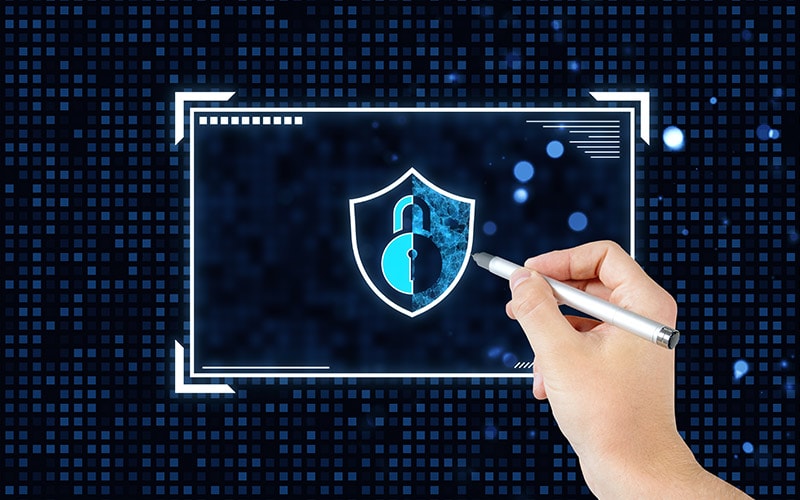
Insights
- Enterprises must prioritize investments in cutting-edge threat detection, employee education, and resilient infrastructure to secure their operations and preserve stakeholder confidence in an unpredictable digital landscape.
- Implementing zero trust at scale is a strategic approach to protecting digital ecosystems.
- Achieving zero trust relies on network modernization, cloud security, data safeguarding, and securing operational technologies.
- AI enhances decision-making by enabling faster, smarter responses to evolving threats.
As cyberthreats evolve at an unprecedented pace, traditional security methods of securing digital assets become obsolete. Data breaches, ransomware, and sophisticated espionage are now the norm, highlighting the urgent need for a strategic cybersecurity shift. Businesses grapple with the challenge of protecting sensitive information in an interconnected digital landscape — all while integrating AI into their operations. Against this backdrop, zero trust at scale emerges as a beacon of hope, promising to redefine cybersecurity in a robust and adaptable way.
How can organizations implement zero trust at scale to safeguard digital ecosystems amid relentless cyberthreats? Zero trust, enhanced by AI and rooted in the principle of "never trust, always verify," enhances security by continuously validating the authenticity of users, devices, and applications. This article draws on insights from a recent conference presentation by Infosys cyber expert Mayank Agarwal. It explores how scaling zero trust addresses the complex security needs of modern enterprises, providing a framework to mitigate risks and enhance resilience against cyber adversaries.
Zero trust represents a significant departure from traditional perimeter-based security models. It envisions a future where trust is never implicitly granted, and every access request is thoroughly scrutinized. The potential improvements are immense: from significantly reducing the attack surface to enhancing visibility and control over digital interactions. This article delves into the transformative potential of zero trust at scale, outlining key components, risks, and technological considerations necessary for successful implementation.
The vision for zero trust at scale
The 2024 cybersecurity landscape presents a Sisyphean challenge for business leaders, as bad actors seemingly outpace even their best efforts. Enterprises face mounting pressure to invest in advanced threat detection and response (TDR), employee training, and resilient infrastructure to safeguard operations and maintain stakeholder trust in a high-risk digital ecosystem.
Zero trust at scale envisions a cybersecurity landscape where the principles of zero trust are comprehensively applied across an organization's entire digital infrastructure. This approach eliminates implicit trust, ensuring that all users and devices are continuously authenticated and authorized before accessing critical resources. Zero trust is enabled through network transformation, cloud security, data protection, and operations technology (OT) security. AI plays a role in each area, making faster and better decisions while continuously adapting to the rapidly evolving threat environment.
Zero trust is enabled through network transformation, cloud security, data protection, and operations technology (OT) security.
Network transformation: Reinventing connectivity. The first component of zero trust at scale is network transformation. Traditional network security models often rely on a secure perimeter to protect internal assets. However, with the rise of remote work and cloud computing, the network perimeter has become increasingly porous. Zero trust requires a fundamental shift toward identity-centric security, where access to resources is based on rigorous authentication and authorization mechanisms. For instance, implementing software-defined perimeters can create secure, context-aware access to network resources, reducing the risk of unauthorized access and lateral movement by attackers.

Cloud security: Securing the digital frontier. The second pillar of zero trust at scale is cloud security. As organizations migrate their workloads to cloud, they face new security challenges that traditional on-premises solutions cannot address. Zero trust advocates for a robust cloud security strategy that includes continuous monitoring, encryption, and microsegmentation to protect cloud-native applications and data. According to a report by Check Point, 82% of cloud deployments encounter security misconfigurations, highlighting the need for a zero-trust approach to ensure comprehensive protection across cloud environments.
Data protection: Safeguarding the crown jewels. Data protection is the third critical component of zero trust at scale. In a digital economy, data is the lifeblood of an organization. Zero-trust principles mandate that data should be encrypted both in transit and at rest, with access tightly controlled and monitored. Advanced data loss prevention (DLP) technologies, combined with user behavior analytics, can detect and mitigate potential data breaches before they escalate. According to a 2024 IBM report, the average cost of a data breach is $4.88 million, underscoring the financial imperative for robust data protection measures.
Advanced data loss prevention (DLP) technologies, combined with user behavior analytics, can detect and mitigate potential data breaches before they escalate.
OT security: Defending critical infrastructure. The fourth component, OT security, focuses on protecting the systems and networks that manage industrial operations. As OT environments become increasingly interconnected with IT networks, they become attractive targets for cyber adversaries. Zero trust at scale for OT involves implementing stringent access controls, continuous monitoring, and anomaly detection to safeguard critical infrastructure. AI plays an important role in anomaly detection, finding irregularities and pattern that proactively flag threats. The 2021 Colonial Pipeline attack, which disrupted fuel supplies across the Eastern US, underscores the vulnerabilities in OT systems and the need for a zero-trust approach to secure these vital assets. That watershed event spurred the US government to improve resilience across the nation’s critical infrastructure.

The risks of zero trust
Implementing zero trust at scale is not without its challenges. Organizations must navigate a complex landscape of risks, including resistance to change, integration complexities, compliance requirements, and the evolving threat landscape. This section provides an overview of these risks, setting the stage for a detailed exploration of each.
Resistance to change. Transitioning to a zero-trust model poses a significant risk because it requires a cultural shift within the organization. Employees and stakeholders must adjust to new security protocols and practices. To overcome this resistance and ensure a smooth transition, effective change management strategies are essential.
Integration complexities. Organizations often have a diverse IT ecosystem comprising legacy systems, third-party applications, and modern cloud services. Integrating these disparate elements into a cohesive zero-trust framework can be challenging and resource-intensive.
Compliance requirements. Compliance adds another layer of complexity. Organizations must ensure that their zero-trust implementation aligns with industry regulations and standards, such as GDPR, HIPAA, and PCI-DSS. Failure to comply can result in severe legal and financial repercussions.
Evolving threat landscape. Cyber adversaries continuously develop new tactics, techniques, and procedures to bypass security measures. Staying ahead of these threats requires a proactive approach to threat intelligence and continuous improvement in security posture.
Technology aspects of zero trust at scale
Technology plays a pivotal role in enabling zero trust at scale. This section delves into the technological considerations and innovations critical for successful implementation.
Automation and artificial intelligence (AI) are vital for scaling zero trust. Leveraging AI-driven analytics and machine learning enhances TDR capabilities, enabling organizations to quickly identify and mitigate security incidents. For example, automated security orchestration and response (SOAR) solutions streamline incident management, reducing response times and minimizing the impact of attacks.
The integration of zero-trust principles with Google Cloud Platform (GCP) and IPv6 is critical in the modern cybersecurity landscape. GCP offers a scalable, secure infrastructure that supports zero-trust implementation, while IPv6 provides enhanced security features and larger address space, facilitating the deployment of secure, scalable networks.
Infosys and Zscaler
Infosys has a cybersecurity team of 6,200 distributed globally, operating from eight major cyberdefense centers. The company serves over 300 clients and has 15 years of experience in cybersecurity. Their approach focuses on three main initiatives to enhance human potential. First, a partnership with Purdue University ensures comprehensive training and certification for team members. Second, standardized blueprints and architectures streamline operations for engineers and analysts. Third, a bot repository accelerates deployments and automation.
The CyberNext platform provides various services, including security operations center (SOC) services, threat intelligence, threat hunting, vulnerability management, and comprehensive monitoring and reporting. Infosys covers all cybersecurity areas, from identity and access management to cloud security, infrastructure security, governance, risk, and compliance (GRC), privacy, data protection, and TDR.
Infosys has partnered with Zscaler for nine years, marked by deployment capabilities and prebuilt solution accelerators. With over 50 global client engagements, Infosys supports 350,000 users across 60 countries. The company has over 400 certified Zscaler professionals managing more than a million endpoints, earning recognition as GSI Growth Partner of the Year for the Americas.
The partnership between Infosys and Zscaler unites two significant industry players to deliver zero-trust solutions. Zscaler's cloud-native security platform, combined with Infosys's expertise in digital transformation and cybersecurity, provides organizations with a viable framework to implement zero trust at scale. This collaboration also aids the integration of their security solutions, increasing protection across the digital ecosystem.
Zscaler's cloud-native security platform, combined with Infosys's expertise in digital transformation and cybersecurity, provides organizations with a viable framework to implement zero trust at scale.
Expanding horizons: Ethics, collaboration, and geo considerations
Ethical considerations are paramount in deploying zero-trust technologies. Security measures must not infringe on user privacy or civil liberties. Organizations should establish clear policies and governance frameworks to balance security and privacy to foster trust and accountability.
Training and awareness are essential for the success of zero trust at scale. Employees must understand the principles of zero trust and their roles in maintaining security. Regular training sessions and awareness campaigns help cultivate a security-first mindset across the organization.

Network security remains a cornerstone of zero trust at scale. The Zscaler user community is vital in fostering collaboration and knowledge sharing among security professionals. By participating in this community, organizations can stay informed about the latest threats and best practices, enhancing their security posture.
Zscaler private access (ZPA) is a key component of zero-trust architecture, enabling secure, seamless access to internal applications without exposing them to the internet. ZPA leverages identity and context to enforce granular access policies, ensuring only authorized users can access critical resources.
Implementing zero trust globally requires careful consideration of regional regulations and challenges. China, with its unique cybersecurity landscape, presents specific challenges for organizations to navigate. Additionally, adopting a well-architected blueprint framework provides a structured approach to zero trust implementation, ensuring alignment with industry best practices and regulatory requirements.
The journey toward zero trust at scale is complex yet essential for organizations seeking to secure their digital assets in a hostile cyber landscape. By embracing zero-trust principles, organizations can significantly enhance their security posture, mitigate risks, and build resilience against evolving threats. Collaboration between industry leaders like Infosys and Zscaler will drive this adoption, fostering a more secure digital environment for all.





